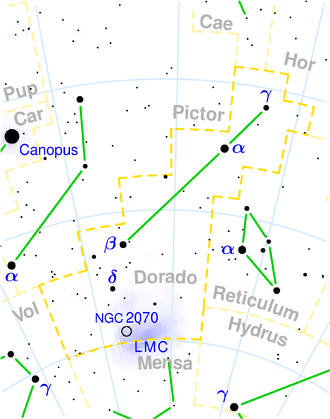NGC 2229
| Galaxy NGC 2229 |
|
|---|---|

|
|
| AladinLite | |
| Constellation | Swordfish |
|
Position equinox : J2000.0 , epoch : J2000.0 |
|
| Right ascension | 06 h 21 m 23.7 s |
| declination | -64 ° 57 ′ 24 ″ |
| Appearance | |
| Morphological type | SAB (s) 0-? / sp |
| Brightness (visual) | 13.5 likes |
| Brightness (B-band) | 14.4 mag |
| Angular expansion | 1.5 ′ × 0.4 ′ |
| Position angle | 133 ° |
| Surface brightness | 12.8 mag / arcmin² |
| Physical data | |
| Affiliation | Abell 3389 |
| Redshift | 0.028116 ± 0.000019 |
| Radial velocity | 8429 ± 6 km / s |
|
Stroke distance v rad / H 0 |
(367 ± 26) · 10 6 ly (112.6 ± 7.9) Mpc |
| history | |
| discovery | John Herschel |
| Discovery date | November 30, 1834 |
| Catalog names | |
| NGC 2229 • PGC 18867 • ESO 087-008 • 2MASX J06212367-6457240 • SGC 062112-6455.8 • | |
| GALEX ASC J062123.71-645723.3 • LDCE 448 NED006 | |
NGC 2229 is a lenticular galaxy of the Hubble type SB0 / a in the constellation Dorado in the southern sky . It is estimated to be 327 million light years away from the Milky Way and has a diameter of around 165,000 ly. Together with NGC 2230 and NGC 2233 , it forms a gravitationally bound galaxy trio.
The galaxies NGC 2228 and NGC 2235 are located in the same area of the sky .
The object was discovered by John Herschel on November 30, 1834 .
